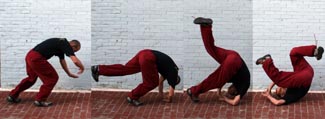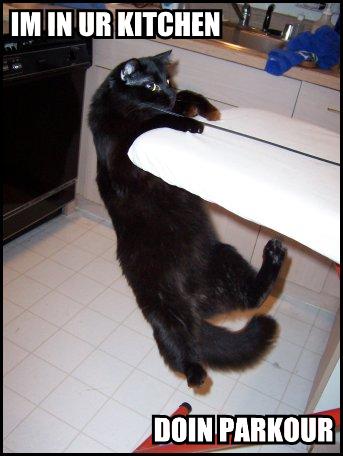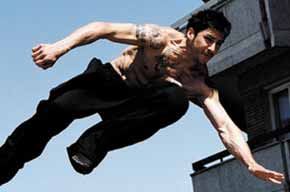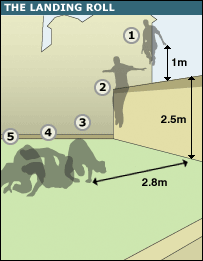Parkour - How to perform an athletic roll to absorb impact of falls

Parkour, Parcour, Parkour
Parkour rolls are useful in all situations. The athletic roll is what really makes parkour effective and useful learn. When learning how to parkour, rolls are completely essential because they can take away up to 60% of the impact of a fall. The reason for this is because it spreads the impact out over a larger surface area, making the impact less concentrated.
If you don't know what parkour is, here's the short definition. It's basically using any means necessary to get from point A to point B as fast as possible. It was invented a long time ago in order to save people who had been injured. Now it has evolved into an amazing form of gymnastics on steroids. If you take the time to learn it, trust me you will not be disappointed.
If you want to learn exactly how to perform a parkour roll, you have come to the perfect place. I'm going to give you the basics in short, easy to read steps, along with the reasoning for why you should do so. If you need a visual representation, I have included some very helpful videos that have helped me a LOT when I learned it.
There are six different parts to the parkour roll. They are: approach, hands, head, shoulder, actual roll, finish. By the end of this you should know how to roll so well that you will be showing others how to parkour roll.

Be Safe
When attempting anything dealing with parkour, always take precautions and be aware of your physical capabilities and risks. This hub will show you how to successfully use the roll to decrease the amount of impact that you receive when falling, but you choose your risks. If you want to know the progressions, check out the video below.
Approach
With the diversity of parkour, there are tons of ways to approach a roll. It can be used at the end of most moves. The reason for this diversity is because you can jump off of anything and finish with an athletic roll. The two types that I'm going to show you are diving rolls and walking rolls.
Diving rolls are usually used to clear small obstacles like benches, tables, or bushes, and walking rolls are useful if you fall or trip and you don't want to smash your face on the ground.
Diving Rolls - Get enough speed and height to clear your obstacle. You want to body to flow in a smooth, arcing motion. Do NOT slow down before you make your jump. When you get close, bring your arms in front of you so that your body follows the path of your arms. Easy enough.
Walking Rolls - Mostly used so that you can quickly recover from being tripped. All you need to worry about is bracing yourself with your hands, tucking your head so that it does NOT touch the ground, and keeping all your motion continuous.
Think of it as one big continuous flow, not as multiple steps.

Hands, its all about placement
It is necessary to use your hands because they help you place yourself in the right spot that you want to land. When you hit the ground, your hands should be making a triangle with your thumbs and pointer fingers. Use them to tilt your body so that your head (tucked) does not touch the ground. You MUST bend your arms slightly so that your arms will absorb some of the impact.
You can roll two ways: on the left side of your body or the right side of your body. If you roll on the right side, after you make contact with the ground and your hands, roll onto the outside of your right arm.
Gotta Protect that Noggin!!
Head placement is the most important part of the roll. If you get this wrong, it doesn't matter what else you do because the whole point of the roll is to avoid impact and redirect it to places where it will hurt less (i.e. - shoulders and back).
You always want to tuck your head to your shoulder on the opposite side that you are rolling on. For example, if you are rolling on your right side, tuck your head into your left shoulder, and vice versa. Don't force your head into your shoulder as hard as you can, just make it so that it does NOT hit the ground. As you finish the parkour roll, your head should naturally end up in the perfect position to keep moving.

Shoulder Landing and the actual roll
You want to use your shoulders to land the roll. After rolling on your hands and arms, your shoulders should be the first thing to touch the ground. You want to try to land on the back side of the tops of your shoulders where it starts to curve downward.
As you land, you want the contact between you and the ground to create a diagonal line from your shoulder to your opposite hip. For example, if you decide to perform a parcour roll on your right shoulder, you want to end the roll on your left hip.
The reason you don't want to roll straight up and down is because it is bad for your spine. All the pressure from the fall will be directed onto your spine if you go straight heels over head. But if you do this slight twisting motion, the chances of you messing up your spine will be drastically cut.
A little physics for you - The reason the parkour roll helps takes impact away from the fall is because it spreads the fall over a larger surface area and it also increases the time of impact. This is also done in cars because they design them to crunch instead of being invincible. The extra milliseconds you get from the crunching of the car than just being smashed can decrease the impact by up to 80%. The same is true for parkour.
Finishing with style
This mostly has to do with your legs. If you do everything else, this should come natural. The only thing that would help you to know is to place one foot in front of the other as you try to land. To know which foot you put in front of the other, you just use the opposite leg of the arm that you start the roll on. For example, if you start the roll on your right arm, you want your left foot to land first.
If you can get this down and your feet keep slamming onto the floor, this is your problem. If you start your roll on your right arm, you want to bend your left leg in the middle of your roll so that when your left foot hits the ground, it is close to parallel with the floor. As for your right leg, keep it slightly bent. Your left leg and momentum will bring you up to your right leg.
If you keep slamming your heels on the ground, try focussing on your feet. Keep it so that you can easily roll your feet and keep your momentum. To make it easier, try touching your toes to your feet.
For more Parkour Hubs, follow the links below :)
Don't Forget!
If you found this Hub useful, helpful, or just plain liked it, then please don't forget to
- Vote it up,
- Share it with your friends and networks, and
- Comment
Thanks for reading my hub!! If you want to see my other Parkour (PK) Hubs, then check out the links to the right!!









